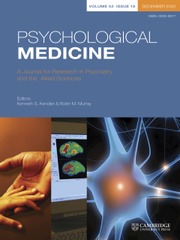Crossref Citations
This article has been cited by the following publications. This list is generated based on data provided by
Crossref.
Landolt, M. A.
Ystrom, E.
Stene-Larsen, K.
Holmstrøm, H.
and
Vollrath, M. E.
2014.
Exploring causal pathways of child behavior and maternal mental health in families with a child with congenital heart disease: a longitudinal study.
Psychological Medicine,
Vol. 44,
Issue. 16,
p.
3421.
Wiggins, Jillian Lee
Mitchell, Colter
Stringaris, Argyris
and
Leibenluft, Ellen
2014.
Developmental Trajectories of Irritability and Bidirectional Associations With Maternal Depression.
Journal of the American Academy of Child & Adolescent Psychiatry,
Vol. 53,
Issue. 11,
p.
1191.
Werner, H
Braegger, CP
Buehr, P
Koller, R
Nydegger, A
Spalinger, J
Heyland, K
Schibli, S
and
Landolt, MA
2015.
Shorter time since inflammatory bowel disease diagnosis in children is associated with lower mental health in parents.
Acta Paediatrica,
Vol. 104,
Issue. 1,
p.
e32.
Wickham, Maeve E.
Senthilselvan, Ambikaipakan
Wild, T. Cameron
Hoglund, Wendy L.G.
and
Colman, Ian
2015.
Maternal Depressive Symptoms During Childhood and Risky Adolescent Health Behaviors.
Pediatrics,
Vol. 135,
Issue. 1,
p.
59.
Hammerton, Gemma
Mahedy, Liam
Mars, Becky
Harold, Gordon T.
Thapar, Anita
Zammit, Stanley
Collishaw, Stephan
and
Ebmeier, Klaus
2015.
Association between Maternal Depression Symptoms across the First Eleven Years of Their Child’s Life and Subsequent Offspring Suicidal Ideation.
PLOS ONE,
Vol. 10,
Issue. 7,
p.
e0131885.
Cheng, Erika R.
Palta, Mari
Poehlmann-Tynan, Julie
and
Witt, Whitney P.
2015.
The Influence of Children's Cognitive Delay and Behavior Problems on Maternal Depression.
The Journal of Pediatrics,
Vol. 167,
Issue. 3,
p.
679.
Bahk, Jinwook
Yun, Sung-Cheol
Kim, Yu-mi
and
Khang, Young-Ho
2015.
Changes in the Relationship Between Socioeconomic Position and Maternal Depressive Symptoms: Results from the Panel Study on Korean Children (PSKC).
Maternal and Child Health Journal,
Vol. 19,
Issue. 9,
p.
2057.
Mars, Becky
Collishaw, Stephan
Hammerton, Gemma
Rice, Frances
Harold, Gordon T.
Smith, Daniel
Bevan Jones, Rhys
Sellers, Ruth
Potter, Robert
Craddock, Nicolas
Thapar, Ajay K.
Heron, Jon
and
Thapar, Anita
2015.
Longitudinal symptom course in adults with recurrent depression: Impact on impairment and risk of psychopathology in offspring.
Journal of Affective Disorders,
Vol. 182,
Issue. ,
p.
32.
Kingsbury, Ann M.
Hayatbakhsh, Reza
Mamun, Abdullah M.
Clavarino, Alexandra M.
Williams, Gail
and
Najman, Jake M.
2015.
Trajectories and Predictors of Women’s Depression Following the Birth of an Infant to 21 Years: A Longitudinal Study.
Maternal and Child Health Journal,
Vol. 19,
Issue. 4,
p.
877.
Ringoot, Ank P.
van der Ende, Jan
Jansen, Pauline W.
Measelle, Jeffrey R.
Basten, Maartje
So, Pety
Jaddoe, Vincent W. V.
Hofman, Albert
Verhulst, Frank C.
and
Tiemeier, Henning
2015.
Why Mothers and Young Children Agree or Disagree in Their Reports of the Child’s Problem Behavior.
Child Psychiatry & Human Development,
Vol. 46,
Issue. 6,
p.
913.
van der Waerden, J.
Galéra, C.
Saurel-Cubizolles, M.-J.
Sutter-Dallay, A.-L.
and
Melchior, M.
2015.
Predictors of persistent maternal depression trajectories in early childhood: results from the EDEN mother–child cohort study in France.
Psychological Medicine,
Vol. 45,
Issue. 9,
p.
1999.
Giallo, Rebecca
Woolhouse, Hannah
Gartland, Deirdre
Hiscock, Harriet
and
Brown, Stephanie
2015.
The emotional–behavioural functioning of children exposed to maternal depressive symptoms across pregnancy and early childhood: a prospective Australian pregnancy cohort study.
European Child & Adolescent Psychiatry,
Vol. 24,
Issue. 10,
p.
1233.
van der Waerden, Judith
Galéra, Cédric
Larroque, Béatrice
Saurel-Cubizolles, Marie-Josèphe
Sutter-Dallay, Anne-Laure
and
Melchior, Maria
2015.
Maternal Depression Trajectories and Children's Behavior at Age 5 Years.
The Journal of Pediatrics,
Vol. 166,
Issue. 6,
p.
1440.
de Barse, Lisanne M.
Tharner, Anne
Micali, Nadia
Jaddoe, Vincent V.W.
Hofman, Albert
Verhulst, Frank C.
Franco, Oscar H.
Tiemeier, Henning
and
Jansen, Pauline W.
2015.
Does maternal history of eating disorders predict mothers' feeding practices and preschoolers' emotional eating?.
Appetite,
Vol. 85,
Issue. ,
p.
1.
Whelan, Yvonne M.
Leibenluft, Ellen
Stringaris, Argyris
and
Barker, Edward D.
2015.
Pathways from maternal depressive symptoms to adolescent depressive symptoms: the unique contribution of irritability symptoms.
Journal of Child Psychology and Psychiatry,
Vol. 56,
Issue. 10,
p.
1092.
Matijasevich, Alicia
Murray, Joseph
Cooper, Peter J.
Anselmi, Luciana
Barros, Aluísio J.D.
Barros, Fernando C.
and
Santos, Iná S.
2015.
Trajectories of maternal depression and offspring psychopathology at 6 years: 2004 Pelotas cohort study.
Journal of Affective Disorders,
Vol. 174,
Issue. ,
p.
424.
Buder, Kathrin
Werner, Helene
Landolt, Markus A.
Neuhaus, Thomas J.
Laube, Guido F.
and
Spartà, Giuseppina
2016.
Health-related quality of life and mental health in parents of children with hemolytic uremic syndrome.
Pediatric Nephrology,
Vol. 31,
Issue. 6,
p.
923.
Maselko, Joanna
Sikander, Siham
Bangash, Omer
Bhalotra, Sonia
Franz, Lauren
Ganga, Nima
Rajan, Divya Guru
O’Donnell, Karen
and
Rahman, Atif
2016.
Child mental health and maternal depression history in Pakistan.
Social Psychiatry and Psychiatric Epidemiology,
Vol. 51,
Issue. 1,
p.
49.
Prady, Stephanie L.
Pickett, Kate E.
Croudace, Tim
Mason, Dan
Petherick, Emily S.
McEachan, Rosie R.C.
Gilbody, Simon
and
Wright, John
2016.
Maternal psychological distress in primary care and association with child behavioural outcomes at age three.
European Child & Adolescent Psychiatry,
Vol. 25,
Issue. 6,
p.
601.
Fomby, Paula
Goode, Joshua A.
and
Mollborn, Stefanie
2016.
Family Complexity, Siblings, and Children’s Aggressive Behavior at School Entry.
Demography,
Vol. 53,
Issue. 1,
p.
1.

